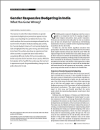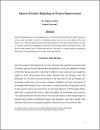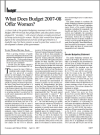FOUND 16 RESULTS
The article examines the two main strategies adopted by the Government of India for institutionalizing gender responsive budgeting to highlight what has gone wrong and what needs to be fixed in order to achieve better outcomes for women. This article by Yamini Mishra and Navanita Sinha was published in Economic and Political Weekly.
This paper is an attempt to measure the effectiveness of Gender Budgeting as a tool for women empowerment. In recent years, Gender Budget Initiatives have emerged as an effective way to bridge gender gaps. First step towards this goal was taken by Australia, South Africa and Philippines followed by other developed and less developed countries including India.
This report presents the findings of a country review carried out in India by Benita Sharma and Aruna Kanchi under the programme "Integrating gender responsive budgeting into the aid effectiveness agenda" launched by UNIFEM and the European Commission (EC) in 2008.The report discusses the use of and opportunities for Gender Responsive Budgeting (GRB) tools and strategies in national level processes and instruments, including utilization of external assistance in the light of India. The first...
This report highlights the work carried out by UNIFEM and its partners throughout the lifetime of the project, Local Level Gender Responsive Budgets Initiatives. The overall objective of the programme was to advocate for and support the transformation of economic governance and leadership into a more gender responsive governance in order to improve gender equality and increase women's participation in decision making process that shape their lives.
This article takes a closer look at the gender budgeting statement in the Union Budget 2007-08 in India and reveals that programmes and allocations remain plagued by mistakes, with several schemes wrongly prioritised as being exclusively for women. Economic and Political Weekly April 21, 2007




